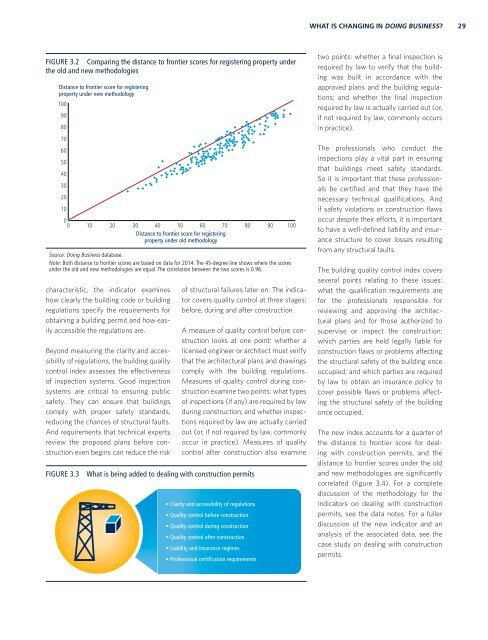Doing Business 2016
1LWKJHK
1LWKJHK
You also want an ePaper? Increase the reach of your titles
YUMPU automatically turns print PDFs into web optimized ePapers that Google loves.
What is changing in <strong>Doing</strong> <strong>Business</strong>?<br />
29<br />
FIGURE 3.2 Comparing the distance to frontier scores for registering property under<br />
the old and new methodologies<br />
Distance to frontier score for registering<br />
property under new methodology<br />
100<br />
90<br />
80<br />
70<br />
60<br />
50<br />
40<br />
30<br />
20<br />
10<br />
0<br />
0 10 20 30 40 50 60 70 80 90 100<br />
Distance to frontier score for registering<br />
property under old methodology<br />
Source: <strong>Doing</strong> <strong>Business</strong> database.<br />
Note: Both distance to frontier scores are based on data for 2014. The 45-degree line shows where the scores<br />
under the old and new methodologies are equal. The correlation between the two scores is 0.96.<br />
characteristic, the indicator examines<br />
how clearly the building code or building<br />
regulations specify the requirements for<br />
obtaining a building permit and how easily<br />
accessible the regulations are.<br />
Beyond measuring the clarity and accessibility<br />
of regulations, the building quality<br />
control index assesses the effectiveness<br />
of inspection systems. Good inspection<br />
systems are critical to ensuring public<br />
safety. They can ensure that buildings<br />
comply with proper safety standards,<br />
reducing the chances of structural faults.<br />
And requirements that technical experts<br />
review the proposed plans before construction<br />
even begins can reduce the risk<br />
of structural failures later on. The indicator<br />
covers quality control at three stages:<br />
before, during and after construction.<br />
A measure of quality control before construction<br />
looks at one point: whether a<br />
licensed engineer or architect must verify<br />
that the architectural plans and drawings<br />
comply with the building regulations.<br />
Measures of quality control during construction<br />
examine two points: what types<br />
of inspections (if any) are required by law<br />
during construction; and whether inspections<br />
required by law are actually carried<br />
out (or, if not required by law, commonly<br />
occur in practice). Measures of quality<br />
control after construction also examine<br />
FIGURE 3.3 What is being added to dealing with construction permits<br />
• Clarity and accessibility of regulations<br />
• Quality control before construction<br />
• Quality control during construction<br />
• Quality control after construction<br />
• Liability and insurance regimes<br />
• Professional certification requirements<br />
two points: whether a final inspection is<br />
required by law to verify that the building<br />
was built in accordance with the<br />
approved plans and the building regulations;<br />
and whether the final inspection<br />
required by law is actually carried out (or,<br />
if not required by law, commonly occurs<br />
in practice).<br />
The professionals who conduct the<br />
inspections play a vital part in ensuring<br />
that buildings meet safety standards.<br />
So it is important that these professionals<br />
be certified and that they have the<br />
necessary technical qualifications. And<br />
if safety violations or construction flaws<br />
occur despite their efforts, it is important<br />
to have a well-defined liability and insurance<br />
structure to cover losses resulting<br />
from any structural faults.<br />
The building quality control index covers<br />
several points relating to these issues:<br />
what the qualification requirements are<br />
for the professionals responsible for<br />
reviewing and approving the architectural<br />
plans and for those authorized to<br />
supervise or inspect the construction;<br />
which parties are held legally liable for<br />
construction flaws or problems affecting<br />
the structural safety of the building once<br />
occupied; and which parties are required<br />
by law to obtain an insurance policy to<br />
cover possible flaws or problems affecting<br />
the structural safety of the building<br />
once occupied.<br />
The new index accounts for a quarter of<br />
the distance to frontier score for dealing<br />
with construction permits, and the<br />
distance to frontier scores under the old<br />
and new methodologies are significantly<br />
correlated (figure 3.4). For a complete<br />
discussion of the methodology for the<br />
indicators on dealing with construction<br />
permits, see the data notes. For a fuller<br />
discussion of the new indicator and an<br />
analysis of the associated data, see the<br />
case study on dealing with construction<br />
permits.


